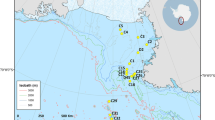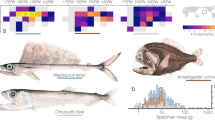Synopsis
New information regarding the ecology ofScytalina cerdale was obtained over a four year period as a consequence of a long-term marine ecological study at the Diablo Canyon Power Plant (DCPP), San Luis Obispo County, California. Twenty intertidal fish surveys were conducted at approximately quarterly intervals, between March 1979 and June 1983, at three separate rocky shore locations (stations). During each survey, a total of 108 square meters (36 m2 per station) was searched for fish during periods of low tide. A total of 280S. cerdale were collected, identified, measured, and released back into the same 4 m2 area, from the same intertidal station (Diablo Cove), throughout the study period. This limited intertidal occurrence most likely reflectsS. cerdale microhabitat requirements; a combination of intertidal elevation (mean = +0.3 MLLW), substratum specificity (loose gravel, 5–10mm size range, overlying a base of sand and shell fragments), and degree of wave exposure (semi-protected). Throughout the study,S. cerdale was seasonally more abundant during summer months (June through August) and less abundant during winter months (November through February). The only exception to this abundance trend followed the 1982 winter storms, which coincided with an El Niño event, whenS. cerdale abundance uncharacteristically dropped during the subsequent 1983 spring and summer surveys. Mean total lengths did not vary greatly, reflecting the absence of early juvenile fishes, and relatively high mean fish densities (3.5 fish per m2 for 20 surveys) were recorded. Qualitative comparisons betweenS. cerdale abundance and seasonal changes in water temperature indicated an inverse relationship. Gravid females, demersal egg masses, and early juvenile individuals were never observed during the four years of the study. This suggests that unlike most other intertidal fishes, particularly other blennioids,S. cerdale may not utilize the intertidal zone for reproductive and recruitment purposes; Diablo Canyon is the most southerly reported distribution for this intertidal species, and therefore, may not entirely represent the species' biology as a whole.
Similar content being viewed by others
References cited
Barton, M.G. 1973. Studies on the intertidal vertical distribution, food habits, and movements of five species of eel blennies (Pisces: Stichaeidae and Pholididae) at San Simeon, California. M.A. Thesis, California State University, Fullerton. 109 pp.
Barton, M.G. 1978. Influence of temperature and salinity on the adaptation ofAnoplarchus purpurescens andPholis ornata to an intertidal habitat. Ph.D. Dissertation, Oregon State University, Corvallis. 105 pp.
Bodkin, J.L., G.R. VanBlaricom & R.J. Jameson. 1987. Mortalities of kelp forest fishes associated with large oceanic waves off central California, 1982–1983. Env. Biol. Fish. 18: 73–76
Burge, R.T. & S.A. Schultz. 1973. The marine environment in the vicinity of Diablo Cove with special reference to abalones and bony fishes. Calif. Dep. Fish Game, MRO Ref. Rep., No. 19. 433 pp
Burgess, T.J. 1978. The comparative ecology of two sympatric polychromatic populations ofXererpes fucorum (Pisces: Pholididae) from the rocky intertidal zone of central California. J. Exp. Mar. Biol. Ecol. 35: 43–58
Carr, M.H. 1983. Spatial and temporal patterns of recruitment of young-of-the-year rockfishes (Sebastes) into a central California kelp forest. M.A. Thesis, California State University, San Francisco. 103 pp
Connel, J.H. 1975. Some mechanisms producing structure in natural communities: a model and evidence from field experiments. pp. 360–490.In: M.L. Cody & J.M. Diamond
Ebeling, A.W., D.R. Laur & R.J. Rowley. 1985. Severe storms disturbances and reversal of community structure in a southern California kelp forest. Mar. Biol. 84: 287–294
Ebert, E.E. 1966. An evaluation of marine resources in the Diablo Canyon area, May 2–4,1966. MRO Ref. No. 66–10. Calif. Dept. Fish Game, Special Study. 14 pp
Ehrlich, K.F., J.M. Hood, G. Muszynski & G.E. McGowen. 1979. Thermal behavioral responses of selected California littoral fishes. U.S. Fish. Bull. 76: 837–849
Eschmeyer, W.N., E.S. Herald & H. Hammann. 1983. A field guide to the Pacific coast fishes of North America. Houghton Mifflin Company, Boston. 336 pp
Follett, W.I. 1970. Benthic fishes cast ashore by giant waves near Pt. Joe, Monterey County, California. Proceedings of the California Academy of Sciences, Fourth Series 37: 473–488
Gibson, R.N. 1969. The biology and behavior of littoral fish. Oceanogr. Mar. Biol. Ann. Rev. 7: 307–410
Gibson, R.N. 1982. Recent studies on the biology of intertidal fishes. Oceanogr. Mar. Biol. Ann. Rep. 20: 363–414
Gotshall, D.W., L.L. Laurent, S.L. Owen, J. Grant & P. Law. 1984. A quantitative ecological study of selected nearshore plants and animals at the Diablo Canyon Power Plant site: a pre-operational baseline 1973–1978. Calif. Dept. Fish Game Res., Mar. Res. Tech. Rpt. No. 48. 726 pp
Gotshall, D.W., J.R.R. Ally, D. L. Vaughn, B. B. Hatfield & P. Law. 1986. Pre-operational baseline studies of selected nearshore marine biota at the Diablo Canyon Power Plant site: 1979–1982. Calif. Dept. Fish Game Res., Mar. Res. Tech. Rpt. No. 50. 370 pp.
Graham, J.B., C.B. Jones & I. Rubinoff. 1985. Behavioral, physiological, and ecological aspects of the amphibious life of the pearl blennyEntomacrodus nigricans Gill. J. Exp. Mar. Biol. Ecol. 89: 255–268
Green, J. 1971. Field and laboratory activity patterns of the tidepool cottidOligocottus maculosus Girard. Can. J. Zool. 49: 225–264
Grossman, G.D. 1982. Dynamics and organization of a rocky intertidal fish assemblage: the persistence and resilience of taxocene structure. Amer. Nat. 119: 611–637
Hart, J.L. 1973. Pacific fishes of Canada. Fish. Res. Board Can. Bull. 180: 739 pp
Horn, M.H. 1983. Optimal diets in complex environments: feeding strategies of two herbivorous fishes from a temperate rocky intertidal zone. Oecologia (Berlin) 58: 345–350
Horn, M.H. & R.N. Gibson. 1988. Intertidal fishes. Sci. Amer. 258: 64–70
Horn, M.H. & K.C. Riegle. 1981. Evaporative water loss and intertidal vertical distribution in relation to body size and morphology of stichaeiod fishes from California. J. Exp. Mar. Biol. Ecol. 50: 273–288
Horn, M.H., S.N. Murray & T.W. Edwards. 1982. Dietary selectivity in the field and food preferences in the laboratory for two herbivorous fishes from a temperate intertidal zone. Mar. Biol. 67: 237–246
Horn, M.H., S.N. Murray & R.R. Seapy. 1983. Seasonal structure of a central California rocky intertidal community in relation to environmental variations. Bull. South. Calif. Acad. Sci. 82: 79–94
Hubbs, C.L. 1960. The marine vertebrates of the outer coast. Syst. Zool. 9: 134–147
Kelly, J. & D.W. Behrens. 1985. Intertidal fish community study at Diablo Canyon Power Plant. Environmental Investigations at Diablo Canyon, 1984, Dept. Eng. Res., Pacific Gas & Electric Co., San Ramon. 74 pp
Marliave, J.B. 1975. Seasonal shifts in the spawning site of a northeast Pacific intertidal fish. J. Fish. Res. Board. Can. 32: 1687–1691
Marliave, J.B. 1977. Substratum preferences of settling larvae of marine fishes reared in the laboratory. J. Exp. Mar. Biol. Ecol. 27: 47–60
Marliave, J.B. 1986. Lack of planktonic dispersal of rocky intertidal fish larvae. Trans. Amer. Fish. Soc. 115: 149–154.
Marliave, J.B. & E.E. DeMartini. 1977. Parental behavior of intertidal fishes of the stichaeid genusXiphister. Can. J. Zool. 55: 60–63
Miller, D.J.& R.N. Lea. 1972. Guide to the coastal marine fishes of California. Dept. of Fish & Game, Fish Bull. 57. 249 pp
Miller, K.A. & W.H. Marshall. 1987. Food habits of the large monkeyface prickleback,Cebidichthys violaceus. Calif. Fish and Game 73: 37–44
Mollick, R.S. 1968. The distribution ofClinocottus analis in tidepools as related to substrate preference. M.S. Thesis, San Diego State University, San Diego. 86 pp
Nakamura, R. 1976. Experimental assessment of factors influencing microhabitat selection by two tidepool fishesOligocottus maculosus andO. snyderi. Mar. Biol. 37: 97–104
Norris, K.S. 1963. The function of temperature in the ecology of the percoid fishGirella nigricans (Ayres). Ecol. Monogr. 33: 23–62
North, W.J. 1969. An evaluation of the marine flora and fauna in the vicinity of Diablo Cove, California. Mar. Adv., La Jolla 1097–1128
North, W. J., E. K. Anderson & F.A. Chapman. 1974. Summary report on marine ecological studies: environmental investigations at Diablo Canyon, 1972–1973. Pac. Gas & Elec., Dept. Engr. Res. 51–76
North, W.J., F.A. Chapman & E.K. Anderson. 1986. W.J. North marine ecological investigations, 1985: environmental investigations at Diablo Canyon, 1985. Pac. Gas & Elec., Dept. Engr. Res. 9–23.
Phillips, R.R. 1977. The relationship between social behavior and use of space in the benthic fishChasmodes bosquianus (Blenniidae). Behaviour 60: 1–27
Pimentel, R.A. & R.C. Bowker. 1984. Diablo Canyon intertidal fish study and communtiy structure analysis report for survey 2 through 15: environmental investigations at Diablo Canyon, 1972–1973. Pac. Gas & Elec., Dept. Engr. Res. 78 pp
Quast, J.C. 1968. New records of thirteen cottid and blennioid fishes for southeastern Alaska. Pac. Sci. 22: 482–487
Richkus, W.A. 1981. Laboratory studies of interspecific behavioral interactions and factors influencing tidepool selection of the wooly sculpin (Clinocottus analis). Cal. Dept. Fish Game 67: 187–195
Ricketts, E.F., J. Calvin & J.W. Hedgpeth. 1968. Between Pacific tides, 4th edition. Stanford University Press, Stanford. 614 pp
Schultz, L.P. & A.C. DeLacy. 1936. Fishes of the American Northwest. A catalogue of the fishes of Washington and Oregon, with distributional records and a bibliography. J. Pan. Pac. Res. Inst. 11 (1 & 4)
Setran, A.C. 1989. Distribution, abundance and ecological requirements for larvae and young-of-the-year of two sympatric blennioid fishes (Cebidichthys violaceus andXiphister mucosus). M.S. Thesis, San Diego State University, San Diego. 110 pp.
Seymour, R.J. 1983. Extreme waves in California during winter, 1983. State of California, The Resources Agency, Dept. of Boat. Waterways, Sacramento. 9 pp
Singer, M.M. 1985. Food habits of juvenile rockfishes (Sebastes) in a central California kelp forest. U.S. Fish. Bull. 83: 531–541
Stephens, Jr., M.S., R.N. Johnson, G.S. Key & J.E. McCosker. 1970. The comparative ecology of the three sympatric species of California blennies of the genusHypsoblennius Gill (Teleostomi: Blenniidae). Ecol. Monogr. 40: 213–233.
Thomson, D.A. & C.E. Lehner. 1976. Resilience of a rocky intertidal fish community in a physical unstable environment. J. Exp. Mar. Biol. Ecol. 22: 1–29
Wilimovsky, N.J. 1954. List of fishes of Alaska. Stanford Ichthyol. Bull. 4: 279–294
Wilimovsky, N.J. 1964. Inshore fish fauna of Aleutian archipelago. Proc. Alaskan Sci. Conf. 14: 172–190
Wilkie, D.W. 1966. Color pigments in the penpoint gunnel,Apodichthys flavidus, and their ecological significance. M.S. Thesis, University of British Columbia, Vancouver. 143 pp
Wingert, R.C. 1974. Comparative reproductive cycles and growth histories of two species ofXiphister (Pisces: Stichaeidae), from San Simeon, California. M.A. Thesis, California State University, Fullerton. 91 pp.
Wourms, J.P. & D. Evans. 1974. The annual reproductive cycle of the black prickleback,Xiphister atropurpureus, a Pacific Coast blennioid fish. Can. J. Zool. 52: 795–802.
Yoshiyama, R.M. 1981. Distribution and abundance patterns of rocky intertidal fishes in central California. Env. Biol. Fish. 6: 315–332
Yoshiyama, R.M., C. Sassaman & R.N. Lea. 1986. Rocky intertidal fish communities of California: temporal and spatial variation. Env. Biol. Fish. 17: 23–40
Author information
Authors and Affiliations
Rights and permissions
About this article
Cite this article
Setran, A.C., Behrens, D.W. New ecological information onScytalina cerdale (Pisces: Scytalinidae) from a central California rocky intertidal zone. Environ Biol Fish 29, 107–117 (1990). https://doi.org/10.1007/BF00005027
Received:
Accepted:
Issue Date:
DOI: https://doi.org/10.1007/BF00005027




